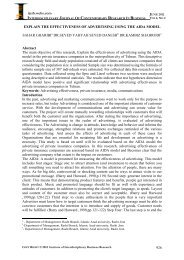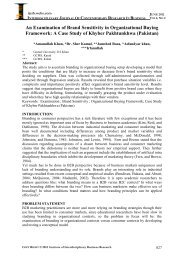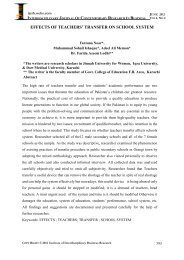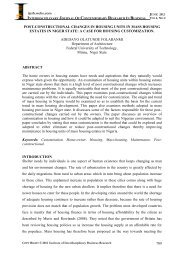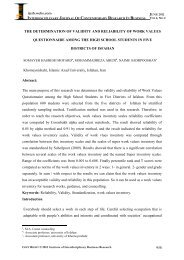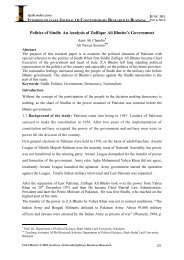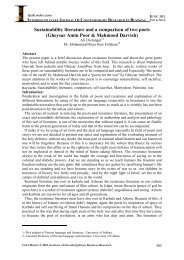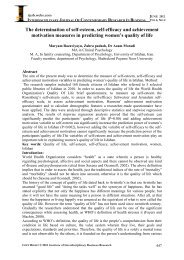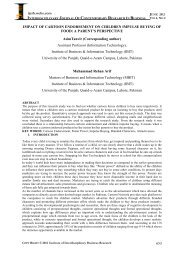The Role of the Psychological Capital on Quality of Work Life And ...
The Role of the Psychological Capital on Quality of Work Life And ...
The Role of the Psychological Capital on Quality of Work Life And ...
Create successful ePaper yourself
Turn your PDF publications into a flip-book with our unique Google optimized e-Paper software.
ijcrb.webs.com<br />
INTERDISCIPLINARY JOURNAL OF CONTEMPORARY RESEARCH IN BUSINESS<br />
COPY RIGHT © 2012 Institute <str<strong>on</strong>g>of</str<strong>on</strong>g> Interdisciplinary Business Research<br />
JUNE 2012<br />
VOL 4, NO 2<br />
health care organizati<strong>on</strong>s such as Hospitals. Fur<str<strong>on</strong>g>the</str<strong>on</strong>g>rmore, to <str<strong>on</strong>g>the</str<strong>on</strong>g> best <str<strong>on</strong>g>of</str<strong>on</strong>g> our knowledge, little<br />
attenti<strong>on</strong> has been paid to <str<strong>on</strong>g>the</str<strong>on</strong>g> role <str<strong>on</strong>g>of</str<strong>on</strong>g> PsyCap in QWL and Job Performance. Thus, <str<strong>on</strong>g>the</str<strong>on</strong>g><br />
purpose <str<strong>on</strong>g>of</str<strong>on</strong>g> this study is to investigate <str<strong>on</strong>g>the</str<strong>on</strong>g> roles <str<strong>on</strong>g>of</str<strong>on</strong>g> PsyCap in job performance and QWL in<br />
private and public Hospitals <str<strong>on</strong>g>of</str<strong>on</strong>g> Mashhad city.<br />
Background and Research Hypo<str<strong>on</strong>g>the</str<strong>on</strong>g>ses<br />
Fig.1 depicts a c<strong>on</strong>ceptual model explaining <str<strong>on</strong>g>the</str<strong>on</strong>g> role <str<strong>on</strong>g>of</str<strong>on</strong>g> PsyCap in QWL and subsequently in<br />
job performance.<br />
1. <strong>Quality</strong> <str<strong>on</strong>g>of</str<strong>on</strong>g> <strong>Work</strong> life (QWL):<br />
QWL is defined as “employee satisfacti<strong>on</strong> with a variety <str<strong>on</strong>g>of</str<strong>on</strong>g> needs through resources,<br />
activities, and outcomes stemming from participati<strong>on</strong> in <str<strong>on</strong>g>the</str<strong>on</strong>g> workplace” (Sirgy & et al. 2001)<br />
.Studies dem<strong>on</strong>strate that employees with high QWL tend to report high levels <str<strong>on</strong>g>of</str<strong>on</strong>g><br />
identificati<strong>on</strong> with <str<strong>on</strong>g>the</str<strong>on</strong>g>ir organizati<strong>on</strong>s, job satisfacti<strong>on</strong>, job performance and lower levels <str<strong>on</strong>g>of</str<strong>on</strong>g><br />
turnover and pers<strong>on</strong>al alienati<strong>on</strong> (e.g., Efraty, Sirgy & Claiborne, 1991). One<br />
c<strong>on</strong>ceptualizati<strong>on</strong> <str<strong>on</strong>g>of</str<strong>on</strong>g> QWL, based <strong>on</strong> need-hierarchy <str<strong>on</strong>g>the</str<strong>on</strong>g>ory <str<strong>on</strong>g>of</str<strong>on</strong>g> Maslow, regards QWL as<br />
employee satisfacti<strong>on</strong> <str<strong>on</strong>g>of</str<strong>on</strong>g> seven sets <str<strong>on</strong>g>of</str<strong>on</strong>g> human developmental needs: (1) health and safety<br />
needs, (2) ec<strong>on</strong>omic and family needs, (3) social needs, (4) esteem needs, (5) actualizati<strong>on</strong><br />
needs, (6) knowledge needs, and (7) es<str<strong>on</strong>g>the</str<strong>on</strong>g>tic needs (Marta & et al, 2011).<br />
QWL was c<strong>on</strong>ceptualized in terms <str<strong>on</strong>g>of</str<strong>on</strong>g> need satisfacti<strong>on</strong> stemming from an interacti<strong>on</strong> <str<strong>on</strong>g>of</str<strong>on</strong>g><br />
workers' needs (survival, social, ego, and self-actualizati<strong>on</strong> needs) and those organizati<strong>on</strong>al<br />
resources relevant for meeting <str<strong>on</strong>g>the</str<strong>on</strong>g>m. Robbins (1989) defined QWL as "a process by which an<br />
organizati<strong>on</strong> resp<strong>on</strong>ds to employee needs by developing mechanisms to allow <str<strong>on</strong>g>the</str<strong>on</strong>g>m to share<br />
fully in making <str<strong>on</strong>g>the</str<strong>on</strong>g> decisi<strong>on</strong>s that design <str<strong>on</strong>g>the</str<strong>on</strong>g>ir lives at work. According to QWL is a<br />
philosophy, a set <str<strong>on</strong>g>of</str<strong>on</strong>g> principles, which holds that people are <str<strong>on</strong>g>the</str<strong>on</strong>g> most important resource in <str<strong>on</strong>g>the</str<strong>on</strong>g><br />
organizati<strong>on</strong> as <str<strong>on</strong>g>the</str<strong>on</strong>g>y are trustworthy, resp<strong>on</strong>sible and capable <str<strong>on</strong>g>of</str<strong>on</strong>g> making valuable c<strong>on</strong>tributi<strong>on</strong><br />
and <str<strong>on</strong>g>the</str<strong>on</strong>g>y should be treated with dignity and respect.<br />
QWL has been well recognized as a multi-dimensi<strong>on</strong>al c<strong>on</strong>struct and it may not be universal<br />
or eternal. Beauregard (2007) said that <str<strong>on</strong>g>the</str<strong>on</strong>g> key c<strong>on</strong>cepts captured and discussed in <str<strong>on</strong>g>the</str<strong>on</strong>g><br />
existing literature include job security, better reward systems, higher pay, opportunity for<br />
growth, participative groups, and increased organizati<strong>on</strong>al productivity. In <str<strong>on</strong>g>the</str<strong>on</strong>g> scientific<br />
management traditi<strong>on</strong>, satisfacti<strong>on</strong> with QWL was thought to be based solely <strong>on</strong> "extrinsic"<br />
traits <str<strong>on</strong>g>of</str<strong>on</strong>g> <str<strong>on</strong>g>the</str<strong>on</strong>g> job: salaries and o<str<strong>on</strong>g>the</str<strong>on</strong>g>r tangible benefits, and <str<strong>on</strong>g>the</str<strong>on</strong>g> safety and hygiene <str<strong>on</strong>g>of</str<strong>on</strong>g> <str<strong>on</strong>g>the</str<strong>on</strong>g><br />
workplace. By c<strong>on</strong>trast, <str<strong>on</strong>g>the</str<strong>on</strong>g> human relati<strong>on</strong>s approach stresses that, while extrinsic rewards<br />
are important, "intrinsic rewards" are key predictors <str<strong>on</strong>g>of</str<strong>on</strong>g> productivity, efficiency, absenteeism<br />
and turnover. <str<strong>on</strong>g>The</str<strong>on</strong>g>se intrinsic rewards include traits specific to <str<strong>on</strong>g>the</str<strong>on</strong>g> work d<strong>on</strong>e, <str<strong>on</strong>g>the</str<strong>on</strong>g> "task<br />
c<strong>on</strong>tent": skill levels, aut<strong>on</strong>omy and challenge.<br />
According Robbins QWL is “a process by which an organizati<strong>on</strong> resp<strong>on</strong>ds to employee needs<br />
by developing mechanisms to allow <str<strong>on</strong>g>the</str<strong>on</strong>g>m to share fully in making <str<strong>on</strong>g>the</str<strong>on</strong>g> decisi<strong>on</strong>s that design<br />
<str<strong>on</strong>g>the</str<strong>on</strong>g>ir lives at work”. <str<strong>on</strong>g>The</str<strong>on</strong>g> key elements <str<strong>on</strong>g>of</str<strong>on</strong>g> QWL in <str<strong>on</strong>g>the</str<strong>on</strong>g> literature include job security, job<br />
satisfacti<strong>on</strong>, better reward system, employee benefits, employee involvement and<br />
organizati<strong>on</strong>al performance (Havlovic, 1991). For <str<strong>on</strong>g>the</str<strong>on</strong>g> purpose <str<strong>on</strong>g>of</str<strong>on</strong>g> this study, QWL is defined<br />
as <str<strong>on</strong>g>the</str<strong>on</strong>g> favorable c<strong>on</strong>diti<strong>on</strong> and envir<strong>on</strong>ment <str<strong>on</strong>g>of</str<strong>on</strong>g> employees benefit, employees’ welfare and<br />
management attitudes towards operati<strong>on</strong>al workers as well as employees in general.<br />
<str<strong>on</strong>g>The</str<strong>on</strong>g>re is a plethora <str<strong>on</strong>g>of</str<strong>on</strong>g> literature highlighting <str<strong>on</strong>g>the</str<strong>on</strong>g> factors critical for <str<strong>on</strong>g>the</str<strong>on</strong>g> assessment <str<strong>on</strong>g>of</str<strong>on</strong>g> QWL<br />
(Srinivas, 1994). Attempts also have been made to empirically define QWL (Levine et al.,<br />
1984; Mirvis & Lawler, 1984; Walt<strong>on</strong>, 1974). Comprehensive delineati<strong>on</strong> <str<strong>on</strong>g>of</str<strong>on</strong>g> <str<strong>on</strong>g>the</str<strong>on</strong>g> QWL<br />
c<strong>on</strong>cept is found in three major works: Levine et al. (1984), and Walt<strong>on</strong> (1974). O<str<strong>on</strong>g>the</str<strong>on</strong>g>r<br />
207



